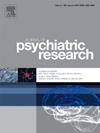Associations between cerebrospinal fluid synaptic protein biomarkers and cognitive function in bipolar disorder
IF 3.7
2区 医学
Q1 PSYCHIATRY
引用次数: 0
Abstract
This study is the first to investigate the association between a comprehensive panel of cerebrospinal fluid (CSF) synaptic protein biomarkers and cognitive function using data from a prospective cohort study including N = 59 patients with bipolar disorder (BD) in remission and N = 37 healthy control individuals (HC). The CSF synaptic protein biomarkers included neuronal pentraxin (NPTX)1, NPTX2, 14-3-3 proteins, AP-2 complex subunit-beta, beta-synuclein, complexin-2, gamma-synuclein, NPTX-receptor, phosphatidylethanolamine-binding proteins, rab GDP dissociation inhibitor-alpha, syntaxins-1B and 7. The biomarkers of synaptic dysfunction were analyzed by targeted mass spectrometry. The primary cognition measure was a global cognitive composite score based on neuropsychological tests of verbal learning and memory, executive function, psychomotor speed, and sustained attention. Our primary hypothesis was that levels of NPTX1 and NPTX2 were associated with global cognition and verbal memory. The study revealed consistent positive associations between CSF concentrations of NPTX1 and NPTX2 and global cognitive function. However, only the association with a tryptic peptide from NPTX2 (VAELEDEK) remained statistically significant after adjustment for multiple tests. No consistent trends or significant relationships were found between NPTX1 and NPTX2 and verbal memory. NPTXs showed positive associations with sustained attention, and the NPTX receptor was positively associated with global cognition scores. Similar trends were found in BD patients and HC individuals. The study provides novel evidence for a potentially pivotal role of CSF synaptic proteins, particularly NPTX1, NPTX2, and NPTX-receptor, in shaping global cognitive function across BD and HC populations and increases our understanding of the neurobiological foundations for cognitive functions across diagnostic boundaries.
求助全文
约1分钟内获得全文
求助全文
来源期刊

Journal of psychiatric research
医学-精神病学
CiteScore
7.30
自引率
2.10%
发文量
622
审稿时长
130 days
期刊介绍:
Founded in 1961 to report on the latest work in psychiatry and cognate disciplines, the Journal of Psychiatric Research is dedicated to innovative and timely studies of four important areas of research:
(1) clinical studies of all disciplines relating to psychiatric illness, as well as normal human behaviour, including biochemical, physiological, genetic, environmental, social, psychological and epidemiological factors;
(2) basic studies pertaining to psychiatry in such fields as neuropsychopharmacology, neuroendocrinology, electrophysiology, genetics, experimental psychology and epidemiology;
(3) the growing application of clinical laboratory techniques in psychiatry, including imagery and spectroscopy of the brain, molecular biology and computer sciences;
 求助内容:
求助内容: 应助结果提醒方式:
应助结果提醒方式:


